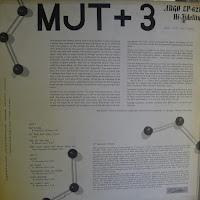Max Roach Quintette - Max
Released 1958
Recording and Session Information
Chicago, January 4 1958 (album cover states 14 January 1958)
Kenny Dorham, trumpet; Hank Mobley, tenor sax; Ramsey Lewis, piano; George Morrow, bass; Max Roach, drums.
Crackle Hut
Speculate
That Ole Devil Love
Audio Blues
C M
Four-X
| Crackle Hut | Owen Marchall | January 14 1958 |
| Speculate | Kenny Dorham | January 14 1958 |
| That Ole Devil Love | A. Roberts, D. Fisher | January 14 1958 |
| Audio Blues | Max Roach | January 14 1958 |
| C M | Hank Mobley | January 14 1958 |
| Four-X | Max Roach | January 14 1958 |
Liner Notes
Max Roach' concluded one aspect of his schooling in 1942.
That same year he began a quest for knowledge that has motivated him to date. It has been a rewarding quest for Roach and for those who have followed his music.
In 1942, Roach, then 17, finished his formal education and entered into the realm of jazz. As a teenager, possessing a passionate interest in jazz, he found working with Charlie Parker a wondrous experience. As a drummer, he was fascinated by the work of Kenny Clarke, then participating in vital sessions at Minton's and other New York clubs.
Roach stopped long enough to absorb Clarke's message, then was on his way. He's been learning his own art, and inspiring others with it, ever since.
He has worked with Coleman Hawkins, Benny Carter, Miles Davis, Parker, Dizzy Gillespie, and many other significant jazzmen. Through his experience with them, he has benefited. These benefits have been reflected in Roach's mastery of his instrument.
Just as Clarke influenced Roach, Roach has influenced many modern jazz drummers. His subtlety, his precision, his inspirational melodic sense, have made him a major figure in jazz.
There are many drummers in jazz. But Roach is one of the few meriting the title "percussionist". Few drummers utilize their instrument in the multi-faceted manner that Roach does. He communicates vividly, because he has liberated his instrument to incorporate in its realm patterns of expression rarely associated with it before Roach.
"One of the prime functions of the drums is to serve as an accompanying instrument," Roach told me during an interview for a story in Down Beat.
As an accompanist, Roach knows his function and performs it with taste and skill.
In discussing this aspect of his role, he added, "This can be developed by listening to everything around you and by fitting yourself in without being smothered or smothering others."
He added, "It's difficult to do, due to the timbre of the instrument. You can't help smothering the horns unless you're very careful. And if you're too delicate, you can't say anything. You need proper balance and respect. It takes a good drummer to get a lot out of the Instrument... "
Roach, to understate it, is "a good drummer".
One key quote which best defines his own approach is this one: "You can play lyrically by phrasing and dynamics. You set up lyrical patterns in rhythm which give indications of the structure of the song you're playing."
Roach concluded his unintentional self-evaluation by noting, think it's important for the drummer to know what's going on around him — harmonically and melodically."
In every sense, Roach is a musician. He listens carefully and astutely to what occurs around him. He reflects the feelings and expressions of his compatriots. He seizes ideas, expands them, and returns them in the form of provocative messages. He utilizes the drums as more than sound-creating devices. He fulfills the musical needs of other musicians during a performance. This fulfilment often leads to specific and long-run progress on their parts.
Roach is more than a time-keeper, Often the sole function of many jazz drummers. Rather than impersonate a metronome, Roach plays several roles. Zealously guarding the beat, Roach is inventive enough to accomplish much more than this single function. He utilizes rhythmic patterns creatively; it is diffcult to predict his musical behavior, yet it is a constant listening challenge. He plays melodically, speaking freely to other instruments.
Roach has spoken often to three of the jazzmen on this recording. Trumpeter Kenny Dorham, tenor man Hank Mobley, and bassist George Morrow, were important in Roach's quintet. Chicago pianist Ramsey Lewis is the newcomer to he Roach sphere oi influence.
Dorham, one of the most honestly creative, yet under-rated, jazzmen, has worked with many leading jazz figures, in addition to Roach. Absorbing the practices of leading trumpeters, he has emerged as an individualist in the world of jazz which often honors mere imitation.
Mobley is one of jazz' most forceful tenor spokesmen. His emotionally charged sound has illuminated many record and live sessions.
Morrow was a member of Roach's original quintet and has worked with Roach as closely as two rhythm section teammates can work, through several years of solos and tunes.
The new talent, Ramsey Lewis, is a Chicagoan. Now in his mid-twenties, Lewis heads his own cohesive trio at Chicago's Cloister. A technically facile pianist, he is classically trained and fervently devoted to jazz. The opportunity to record with Roach, Dorham, Mobley, and Morrow was for Lewis, naturally, a memorable experience.
Roach has come a long way since he emerged from high school in '42. From the Minton's era to the School of Jazz at Lenox, Roach has grown With jazz, in the best sense of the term "evolution". Although many jazz listeners might question Roach's capacity for further growth, after such ambitious development, it is quite likely that he will go on to master more of the comlexities of modern music, without sacrificing his improvisatory brilliance.
In so doing, he may well dwarf his past achievements.
In Roach's case, this is possible.
DON GOLD
Managing Editor
Down Beat Magazine









